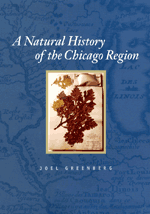In this exclusive online feature, naturalist Joel Greenberg takes readers on a guided tour of eight of the most beautiful natural areas around southern Lake Michigan, from Cliffside Park and Chiwaukee Prairie in Wisconsin to Chicago's lakefront parks, the Indiana Dunes National Lakeshore, and finally to Warren Woods and Grand Mere State Park in Michigan. For more information about these or other natural sites in the region, and the flora and fauna (past and present) that can be found in them, check out Greenberg's new book, A Natural History of the Chicago Region.
Praise for the book:
"[A Natural History of the Chicago Region] is a work of a lifetime, a defining piece of history. . . . What Mike Royko's The Boss did for Chicago politics, Greenberg's book does for the region's natural history. Like Royko's book, it defines the world in terms readable to the lay person."—Dale Bowman, Chicago Sun-Times
"[This] 600-page work chronicles the impact of human beings, from the first explorers and settlers to the present day, on the flora and fauna of the southern tip of Lake Michigan. . . . It's a rich story, which Greenberg tells with an authority that will, I think, satisfy those who know the science and with enough skill to please the casual readers interested in local history, plants or animals. . . . In his Herculean effort, Greenberg has assembled a broad and compelling portrait of interconnected communities, of survival and extinction, tragedies and triumphs. Apart from its value as a guide to our native plants and animals, Greenberg's book is history of the best sort, offering us the past as a lesson for shaping our future."—Jim Gordon, Gary Post-Tribune
"An outstanding natural history in every sense of the term. The most complete look ever at a 300-year transition from wilderness to major urban center, both documenting what has changed and celebrating the remarkable diversity of nature that remains in the Chicago region. In examining the whole spectrum of plant and animal life, it illuminates issues that are significant on a continental level, even globally. Greenberg writes with verve, style, humor, and an eye for those fascinating details that will appeal to a wide range of readers."—Kenn Kaufman, author of Kaufman Focus Guides: Birds of North America
A Naturalist's Tour of Southern Lake Michigan
by Joel Greenberg
author of A Natural History of the Chicago Region
Up until about 13,000 years ago, the area that would become the southern end of Lake Michigan was covered by a vast sheet of ice. As it melted into oblivion, it left behind huge quantities of earth and water that would create most of the topographic features we know today, such as Lake Michigan, the lake plains, moraines, and rivers. In concert with the effects of climate and geography, these varying land surfaces have supported a remarkable array of natural features including spectacular bluffs and dunes, stunning prairies, rare wetlands, ancient forests, and views of migrating birds that are among the most dramatic in inland North America. And just as important, many of these natural wonders are under protection today and easily visited by the public.
What follows is a sample of the variety that still exists in the southern Lake Michigan watershed. These sites all lie on or near the lakefront, except for Warren Woods, which straddles the Galien River, a tributary of Lake Michigan. All of them are interesting in numerous ways, but I have focused on only one or two features characteristic of each site.
Cliffside Park
![]() Chiwaukee Prairie
Chiwaukee Prairie
![]() Illinois Beach State Park
Illinois Beach State Park![]() Chicago Lakefront Parks
Chicago Lakefront Parks![]() Gibson Woods
Gibson Woods![]() Indiana Dunes
Indiana Dunes![]() Warren Woods
Warren Woods![]() Grand Mere State Park
Grand Mere State Park
Cliffside Park
Where: 7375 Michna Road, Crestview, Wisconsin
Getting there: Go east off of 94-41 on 7 mile Road. Go south on Rte 32 and then east on 6 mile Road. After crossing the railroad tracks, turn left immediately on Michna Road and continue to the park entrance.
Contact: Racine County Public Works Department, Parks Division, tel: 262-886-8440
Cliffside Park is probably the best place to see the Lake Border moraines as they tower above the blue waters of Lake Michigan. You can see eroding clay bluffs and the earliest stages of ravines, some of the more dynamic landscapes in the area.
The great Henry Chandler Cowles, called the father of plant ecology, studied these environments a century ago. (Most of his work on the Lake Border moraines was in the Illinois portion, but they are harder to access today.) He wrote that "there can be almost no other habitat in our climate which imposes such severe conditions upon vegetation as an eroding clay bluff." Extremes in temperature, exposure to sun and wind, and the consistency of clay soils (which change from mush to concrete as they dry) provide few advantages to pioneering plants. In fact, during periods of erosion, "all vegetation is impossible."
Eventually, enough material sloughs off the bluff face to reduce its steepness and susceptibility to erosion. Sufficient soil stability allows the formation of a highly distinctive plant community, referred to by Cowles as "the shrub stage of the captured cliff." These slopes are surprisingly rich, for they are enhanced by seeps and small trickles.
These small trickles may in time form ravines. Cowles describes the process of how ravine formation changes vegetation. In its first stage, the ravine "is essentially a desert," erosion preventing the establishment of vegetation. But as the descending water declines in its velocity, the effect is less to deepen than to widen the ravine. Under these new conditions, "the vegetation leaps as it were by bounds through the herbaceous and shrubby stages into a mesophytic forest."
Chiwaukee Prairie State Natural Area

Shooting stars, photo by Edward Prins, from Chiwaukee Prairie Preservation Fund, Inc.
Where: Kenosha County, Wisconsin
Getting there: Go east on 116th Street off Sheridan Road, just north of the Illinois-Wisconsin border.
Contact: Nature Conservancy, Wisconsin Chapter, tel: 608-251-8140
Chiwaukee Prairie comprises approximately 330 acres of low dunes and swales. Most of it is treeless, a function of fire and possibly (to a lesser degree) flooding in wet years.
Wet, mesic, and dry prairie flourish within feet of each other. This rich mosaic is sustained by the subtle variations in topography that assure adequate moisture regardless of precipitation levels in a given year. Thus, during droughts the swales provide habitat for wet and mesic species, and in times of high water the ridgetops can support mesic and dry plants.
Botanists have recorded over 475 species of plants at Chiwaukee Prairie, including such rarities as pink milkwort (Polygala incarnata), which is currently known to exist in the region at only two or three sites; prairie Indian plantain (Cacalia plantaginea); and one of the largest eastern prairie fringed orchid (Habenaria [Platanthera] leucophaea) populations in the Midwest. In the lowest places, roundstem bulrush, swamp milkweed (Asclepias incarnata), blue flag (Iris virginica), and spotted Joe Pye weed (Eupatorium maculatum) find sanctuary. Further up the slight slope, mesic species predominate: big bluestem (Andropogon gerardii), leadplant (Amorpha canescens), colic root (Aletris farinosa), Indian paintbrush (Castilleja coccinea), tall green milkweed (Asclepias hirtella), false toadflax (Comandra umbellata), all three prairie Silphiums, rattlesnake master (Eryngium yuccifolium), and six milkworts. At the driest level, the guild of plants includes prairie dropseed (Sporobolus heterolepis), little bluestem (Andropogon scoparius), purple prairie clover (Petalostemum purpureum), stiff goldenrod (Solidago rigida), and hairy puccoon (Lithospermum croceum).
Shooting stars (Dodecatheon meadia), above all other species, characterize Chiwaukee Prairie. The plant is not particularly uncommon, but in late May it blankets the prairie in such profusion that it attains a level of splendor not exceeded elsewhere in the region. The flowers cluster along the narrow dune tops, delineating these elevations in lines of azure, pink, and white. One anonymous writer describing the area early this century called the shooting stars the particular glory of the low ridges. She said they were plucked in great armfuls.
As you savor the floral beauties, keep your eyes peeled for the Franklin's ground squirrel (Spermophilus franklinii). This once-common prairie animal has become increasingly rare, as its grassland habitat has decreased in the wake of development.
Related links:
- Into the Wild: Chiwaukee Prairie (from Chicago Wilderness magazine)
- Chiwaukee Prairie Preservation Fund (includes plant lists, excerpts from "Chiwaukee Prairie Memories" by Phil Sander, and more)
 Where: Zion, Illinois
Where: Zion, Illinois
Getting there: From Chicago take I-94 north to Grand Avenue East. Turn left on Sheridan Road, then right (east) on Wadsworth Road and follow that to the park entrance.
Contact: Illinois Beach State Park, tel: 847-662-4828
This is the most heavily visited of all Illinois Sate Parks, hosting around 2,000,000 people a year. A lodge, restaurant, picnic areas, fishing ponds, and an extensive beach attract people of many tastes. But what it offers the naturalist is absolutely outstanding. Of all the sites in the entire state of Illinois, more high-quality natural areas survive here than anywhere else.
Well over 650 species of plants have been recorded at the south unit of Illinois Beach State Park. A good way to sample the place is to start at the nature center and walk south along the Dead River to its mouth. This stretch of the route traverses fine sections of mesic and wet prairie, sedge meadow, marsh, and open water. Return via the gravel road through the oak savanna.
On the low dunes at the mouth of the Dead River a regionally unique plant community has arisen that some believe is one of the most beautiful natural landscapes in the state. It may be the defining image of the Illinois dunesland. One local writer described it this way: "the high and dry ridges are covered with the lustrous leaves of the bearberry and with the prostrate sprays of Waukegan Juniper, one of the most beautiful of evergreens—silvery green with whitish berries that turn into purple in the winter."
Waukegan juniper (Juniperus horizontalis) spreads outward from its center, its branches sprouting roots along the way. An individual plant may cover 60 feet. Eventually, as the plant moves, the point where it began may die. Sometimes the ensuing bare patch of sand becomes enlarged and forms a blowout. At other times, however, the space becomes occupied by the common juniper (Juniperus communis), the third most significant member of the heath, as Frank Gates calls this community. Although horizontal juniper once occurred as far south as Lawrence Avenue and Lake Michigan on Chicago's north side, it has never been recorded from the Indiana Dunes.
While its runners are less conspicuous, bearberry (Arctostaphylos uva-ursi) is similar in its growth to the spreading juniper. Both species trap debris and thus promote the accumulation of humus, but with its thicker tangle of branches, the bearberry does so more effectively. Bearberry is also an important food source for wildlife. Numerous birds eat its scarlet berries, and three insects feed on nothing but this plant: hoary elfin butterfly (Callophrys polios), bearberry leafhopper (Texananus cumulatus), and bearberry aphid (Tamalia coweni).
Spring comes late to the park, but by mid-May, conspicuous bursts of color have begun to variegate the tawniness of the sand. Fragile-looking sand cress (Arabis lyrata) emerges early. At the same time that their small white blossoms appear, so does the small white olympia butterfly (Euchloe olympia), whose larvae feed on the plant. Joining the sand cress on the open ground of the savanna are lupine (Lupinus perennis), common blue-eyed grass (Sisyrinchium albidum), hoary puccoon (Lithospermum canescens), starry false Solomon's seal (Smilacina stellata), and several violets. In wetter areas, yellow star grass (Hypoxis hirsuta) and the exotic-looking wood betony or lousewort (Pedicularis canadensis) thrive.
The plants that bloom in summer are far too numerous to enumerate, and the aspect changes throughout the season. Jesse Lowe Smith, a prominent north shore educator and naturalist of the early twentieth century, provides his impression of the dunes, or as he calls them, the Waukegan Flats:
"It is in early summer that the flats begin to show at their best when the coreopsis, the black-eyed Susans, orange-red [prairie] lilies, and the spiked lobelia appear together with two beautiful native orchids, the calopogon and the rose pogonia. . . . These two orchids are as yet abundant in the low grassy shallows of the Flats. . . . Later on come into bloom the shrubby potentilla with yellow blossoms, the prairie clover, evening primrose, Pitcher's thistle, several species of milkweed, of which, the butterfly weed is very conspicuous with its orange-red flower masses."
Late summer and early fall are lovely times at the Illinois Beach State Park as well. Blazing stars of three species sort themselves in appropriate niches from dry foredunes to mesic prairie. Six asters, six goldenrods, and two coneflowers lend another range of hues to the landscape. Inconspicuous and dainty, two ladies' tresses—the nodding (Spiranthes cernua) and the much rarer slender (S. lacera)—are scattered through the swales.
The most regal of all autumnal flowers is the fringed gentian (Gentiana crinita), which is endowed with an intense blue that can best be likened to a cloudless sky. Although the species is now reduced to little clumps here and there along the damp swales, it wasn't always that way. There was a time, now beyond the memories of living souls, when fringed gentian "pastures" spread for acres across the Waukegan flats. As Minnie Horton wrote, not all treasure is at the rainbow's end.
Related links:
- Boating/Fishing at Illinois Beach State Park (from Chicago Area Paddling/Fishing Guide)
- Into the Wild: Illinois Beach State Park (from Chicago Wilderness magazine)
 Where: Chicago, Illinois
Where: Chicago, Illinois
Contact: Chicago Park District, tel: 312-742-PLAY
Chicago boasts 20 miles of beautiful lakefront. It is perhaps the city's defining glory, providing a backdrop for its unique skyline as well as a host of recreational opportunities for millions of people. Biking, jogging, fishing, swimming, or just lollygagging are enjoyed by many there throughout the year.
All these parks are constructed on fill, since the city has crept eastward over the years. Descriptions of the original lakefront do exist, however. John Dean Caton, Chief Justice of the Illinois Supreme Court for 20 years, provides this glimpse of the early 1830s:
"There were along where Michigan Avenue now is walled with palatial mansions innumerable sand hills rising to a considerable height, overrun by the wild juniper loaded with its fragrant berries at the feet of which stretched away to the southeast the soft smooth beach. . . . A pleasant ramble was also found along the beach north of the river where also the drifting sand had been piled by the shifting winds into a thousand hills stretching farther back from the waters than on the south, but here the juniper bush was replaced by a stunted growth of scraggly pines often hilled high up by the drifting sand."
Despite the loss of native vegetation, the lakefront naturalist can still revel in the annual spectacle of bird migration. Lake Michigan is the only great lake on a north-south axis. On days with westerly winds, which predominate in this area, land birds are concentrated on the shore. On days with easterly winds, particularly in the fall, waterbirds are pushed shoreward in large numbers.
Any place along the lakefront can produce interesting finds for the birder. But there are three areas that receive the lion's share of the birder's attention. The farthest north is at Montrose Avenue. Here there is a harbor and small peninsula, on which is located the Magic Hedge, so christened due to its excellence as a birding spot. Just a little bit to the south is the Lincoln Park Bird Sanctuary (between Irving Park and Addison Avenue), an oasis of habitat enclosed within a fence to provide maximum protection. During spring and fall, especially on days with west winds that force birds against the lake, these locations can seethe with flycatchers, vireos, warblers, sparrows, and other migrants. On the City's south side is Jackson Park (just south of the Museum of Science and Industry at 57th Street and Lake Shore Drive), built as part of the 1893 Columbian Exposition. Its open woods, lagoons, gardens, lake promontories, beaches, and lawns have attracted over 300 species of birds over the years. One observer recorded over 30 species of warblers there in a single morning.
Related links:
- "A Bird's Eye View of the Migratory Bird Route" (from City of Chicago Department of Environment)
 Where: 6201 Parrish Avenue, Hammond, Indiana
Where: 6201 Parrish Avenue, Hammond, Indiana
Getting there: Exit onto Kennedy or Cline Avenue in Hammond from I-80/94, go north to 169th Street, then go east to the light on Parrish Avenue. Turn north to the Nature Center at the end of the road.
Contact: Gibson Woods Nature Preserve, tel: 219-844-3188
The changing levels of Lake Michigan and its predecessors over 6,000 years marked Northwestern Lake County in a unique way. A series of 150 old beach ridges and intervening swales spread across the otherwise level plain. Although most of this wetland complex has been destroyed, conservationists have managed to protect several outstanding tracts including Gibson Woods Nature Preserve. Efforts are underway to protect several other remaining parcels.
Because the early botanists knew the this area so well, and discovered within its watery province "so many fine examples of rare and beautiful plants," excellent descriptions of it exist. This is from Herman Pepoon's great work An Annotated Flora of the Chicago Region (1927):
"Many islets, peninsulas, coves, and flats with long stretches of deep water, steep and sloping banks, water-logged trunks of huge pines, shallow water marshes of cat-tail, bur-reed, sedge, and similar plants afforded abundant shelter for delicate forms. The water was always clear, and, before the days of sewage, palatable as the writer many times proved."
Of the many plants that occurred here, the profusion of orchids was and is a major attraction. Floyd Swink has written that 32 species of orchids have been confirmed from the Indiana Dunes, and most of them grew in these sandy swells and swales. Ask the nature center staff what species are in flower.
Two of the most striking species of orchid are the yellow lady slipper (Cyprepedium calceolus), which blooms in mid- to late May, and the showy lady's slipper (Cyprepedium reginae), which blooms in June. The showy was once abundant in the damp places, thriving by the tens of thousands. Not only was its habitat wrecked by development, but the lady's slipper was also cursed by being so singularly gorgeous. Plants were harvested for the florist trade wherever they could be found; thousands were cut for placement on Chicago restaurant tables.
The nature center also maintains one of the best bird feeding operations I know of. Visitors can observe the many species that utilize the feeders through a huge window. One day this May I was treated to red-headed woodpeckers (Melanerpes erythrocephalus), rose-breasted grosbeaks (Pheuticus ludovicianus), scarlet tanagers (Piranga olivacea), indigo buntings (Passerina cyanea), and a Cooper's hawk (Accipiter cooperii), among others. It's not that these species are particularly rare, but to get such close and unobstructed views is indeed unusual.
Related links:
- Gibson Woods Visitors Guide
- Into the Wild: Gibson Woods Nature Preserve (from Chicago Wilderness magazine)
Indiana Dunes National Lakeshore and State Park

Where: National Lakeshore, Porter, Indiana, et al.; State Park, 1600 North 25 E., Chesterton, Indiana
Getting there: From Chicago, take I-90 or I-94 to Highway 12; Dorothy Buell Memorial Visitor Center is located on Highway 12 at Kemil Road, 3 miles east of Highway 49.
Contact: For National Lakeshore, National Park Service, tel: 219-926-7561, ext. 225; for State Park, tel: 219-926-1952
This park of 13,000 acres is an archipelago of protected areas stretching from Miller Beach in Lake County all the way to Mount Baldy in far western LaPorte County. Of all the nation's national parks, only Grand Canyon and Great Smoky Mountains harbor more plants than the Indiana Dunes. With respect to total biodiversity it ranks seventh of all the national parks.
Examples of virtually every type of natural community occurring within the entire region can be found here. Starting inland from the beating waves, the middle beach, usually unscathed by the storms of summer but swept by those of winter, supports a unique but sparse flora. These plants have specific adaptations that enable them to survive the inhospitable conditions, and all are annuals, for the lashing by winter storms would prove fatal to species requiring stability. They must also survive the scourges of wind-driven sand and the scorching summer heat. Sea rocket (Cakile edentula), the dominant member of this community, has thick fleshy leaves resistant to desiccation. Another frequent species, the seaside spurge (Euphorbia polygonifolia) derives protection by growing along the sand in low mats, possessing small glossy leaves, and having a thick latex sap.
Foredunes form where grasses of trees provide enough shelter to allow sand to accumulate. Over time, the westerly winds and lake tides deposit more and more sand until massive dunes are created. The largest of the local dunes was located near Michigan City but was hauled away early last century to make glass. If you want to get a sense of how formidable these mounds of sand are, try hiking to the top of Mount Baldy at the far western end of the lakeshore (the effort can prove to be a real struggle for flabby flatlanders).
Behind the foredunes a special type of wetland sometimes develops. These are known as pannes, shallow troughs of sand kept wet by the water table and/or springs within nearby dunes. Classic examples are those at Miller and West Beach. The calcium-rich (alkaline) water that supports this community gives rise to a fen-like flora that includes lakeshore rush (Juncus balticus), rose gentian (Sabatia angularis), Kalm's St. John's wort (Hypericum kalmianum), and horned bladderwort (Utricularia cornuta).
Pannes are extraordinary for several reasons. In North America they are restricted to the Great Lakes Basin, where development pressure has led the Nature Conservancy to rank them as globally imperiled (G2). There is also tremendous variation among them. A study of Indiana Dune pannes tabulated a total of 74 plant taxa, but of these only 13 were found in all five pannes. These results are explained by changes in alkalinity due to the age of the panne and its distance from the lake.
The Lakeshore is also home to the federally endangered Karner blue butterfly (Lycaeides melissa samuelis). The larvae of this lovely sprite feed exclusively on lupine, a common flower of the black oak savannas that thrive in portions of the dunes. Karner blues are weak flyers, and thus tend to be isolated in colonies. Their maintenance has proved challenging to park land managers, who have to make sure that that the shady environment they need is not allowed to become too dark or too open. A careful regimen of burning is necessary to meet these requirements.
It is impossible to do the Lakeshore proper justice in a brief discussion like this. All sections contain treasures that make exploration exciting. Some of my favorites not already mentioned include Miller Beach (the southernmost point of Lake Michigan, this is a superb place to witness the fall migration of waterbirds, particularly jaegers, a group of birds ordinarily very difficult to see away from the ocean); Indiana Dunes State Park (protected since 1927, this site has the largest expanse of dunes in the Lakeshore; try trails 2 and 10 for an introduction to the biological diversity of the park); and Kemil Woods (near the Buell Visitor Center, this is a wet woods with large stands of paper birch and other trees, as well as a fine array of flowers).
Just as the Indiana Dunes are themselves spectacular, so were the battles to protect them. In the early 1900s, a major effort was launched to create a dunes national park. It would have been the first national park that required the federal government to buy land for that purpose (earlier parks were already in federal ownership). Unfortunately, two key supporters were forced out of the fray (one, a senator, was defeated, and another had health problems) and World War I began. The work was not in vain, however, because it did lead to the establishment of the Indiana Dunes State Park in 1927. Then in the 1950s an even greater fight began. An imposing coalition of industrial giants and powerful politicians decided that the central dunes, which many considered to be the finest of the dunes region, should become a harbor and steel making complex. Arrayed against these plans were many local conservationists and Senator Paul Douglas of Illinois. For a long time, both sides were locked in a stalemate. But eventually the steel companies, which had been steadily buying up the land they wanted, demolished the area and began construction. This then led to the creation of the national lakeshore, and explains its irregular boundaries.
Related links:
- Birdwatching in the Indiana Dunes
- Digital Images of the Indiana Dunes National Lakeshore
- Geology of the Indiana Dunes National Lakeshore
- Into the Wild: Indiana Dunes State Park (from Chicago Wilderness magazine)
- Karner Blue Butterfly
- Save the Dunes Council
 Where: Three Oaks, Michigan
Where: Three Oaks, Michigan
Getting there: Take I-94 to Exit 6 and drive two and a half miles east, towards Three Oaks, Michigan.
Contact: Warren Dunes State Park, Michigan Department of Natural Resources, tel: 616-426-4013
Within this 480-acre site is a 50-acre tract of virgin beech-maple forest that some believe is the finest of its type in the world. Towering trees and a rich understory sprout from the banks of the Galien River. Because of its high quality, scientists have been studying it since the early 1900s.
One aspect of the forest that has long fascinated these scientists is the competition between the forest's two principal trees—sugar maple (Acer saccharum) and beech (Fagus grandifolia). Sapling maples are abundant in the understory, and have led many to conclude that they will take over the canopy now dominated by the beech. Researchers have found, however, that the process is more complicated.
Although not as swift growing as the maple in full light, the beech continues to rise even after an opening in the canopy is mended. The beech is better suited to the waiting game because of an evolutionary tradeoff. The speed with which it increases in height is sacrificed for lateral growth. In the summer forest, muted flecks of light drizzle through little slits in the canopy. Beech send forth long horizontal branches that seek out these glints, and thus over the centuries can pierce the maple curtain. (One beech took over 300 years to reach the canopy.)
The conclusion that beech will maintain their position in Warren Woods is predicated on the assumption that the rate of disturbance, natural or human, will remain low. If large openings in the canopy develop, closure will not be rapid enough to exclude maples. Since 1975, a series of severe storms has dramatically increased the rate of windfall in the woods. For the first three-quarters of this century, the rate of windfall at Warren Woods was about one-tenth of a tree per year per hectare. It is now one to one and a half trees per year per hectare. The forest looks very different now, with numerous maples of all sizes. The ratio of beech to maple in the canopy has dropped to four to one and in about 100 years it is likely to be only two to one, or even one to one. But it is unlikely that Warren Woods will lose its magnificent beech, for enough will win the race to the canopy to ensure survival.
Beech-maple forests feature some of the most beautiful scenes to grace the region. The beech in any season is an exquisite mixture of form, color, and texture that has few equals among its arboreal relations. Open-grown trees are wider then they are tall; limbs of ancient trees bend to touch the earth, the strain of carrying the burden of their age. But lending grace to the massiveness of beech trunks and major branches, delicate twigs reach out with thin and sharply pointed buds.
The slate gray bark, smooth and taut, seems muscular but not sinewy. In the fall, it contrasts with the pale golden leaves in an elegant combination of muted hues. Unfortunately, beech bark creates another effect: whether it is Daniel Boone marking the place where he "cilled a bar" in 1760 or a young couple proclaiming their first love, some citizens get an irresistible urge to carve memorials on the fair surface of the tree. Few local beeches have escaped defacement.
The sugar maple can draw human attention as few other local trees can. A sugar maple in fall is arguably the major jewel in an arboreal crown studded with gems. I quote Donald Culross Peattie, who singles this tree out among the many others that contribute to this "most magnificent display of color in all the kingdom of plants":
"Clearest yellow, richest crimson, tumultuous scarlet, or brilliant orange—the yellow pigments shining through the over-painting of the red—the foliage of sugar maple at once outdoes and unifies the rest. It is like the mighty, marching melody that rides upon the crest of some symphonic weltering sea and, with its crying song, gives meaning to all the calculated dissonance of the orchestra."
Related links:
 Where: Berrien County, Michigan
Where: Berrien County, Michigan
Getting there: Take I-94 to Exit 22 for Stevensville. Go west a quarter mile to Thornton Drive, go south on Thornton Drive a half mile, then turn right at park entrance.
Contact: Warren Dunes State Park, Michigan Department of Natural Resources, tel: 616-426-4013
The dunes of Berrien County share the loftiness of Indiana's, but differ principally in being steeper and supporting a more mesic type of vegetation. Along with black oak on the foredunes, there is red oak. And in protected pockets next to Lake Michigan, hemlock, black walnut, and sugar maple can thrive. There are a number of reasons why this so.
As you travel from the Indiana Dunes into Michigan you cross both climate and fire gradients. Berrien County experiences greater precipitation and more moderate temperatures that produce a longer growing season. The fire issue is more complex. First, there are a number of rivers that act as fire breaks. Among these are Trail Creek in Michigan City and the Galien River at New Buffalo. Second, the Indiana Dunes are aligned east to west and the Berrien County Dunes north to south. This makes the Indiana dunes more accessible to the prevailing westerly winds and the fires they carry, while the Berrien County dunes act as barriers that flames have to skitter up and over. That the Michigan dunes are often steeper further reduces their frequency of burning.
Industry has long coveted these dunes for their sand, and mining has posed an ongoing threat. It seems that dune sand is especially valuable for the manufacture of metal molds used in producing machinery. Because of its chemical composition, this sand can tolerate the extreme heat necessary to melt metals. As a result, conversion of dune sand into foundry sand yields a 10% loss, while the same process using inland sand creates a 50% loss.
Concern over the destruction of these scenic and biologically important lands prompted Michigan to enact the Sand Dunes Protection Act in 1978. Under this regulatory scheme, the state has designated certain dunes as critical, where sand mining is forbidden. Little if any such mining still occurs in Berrien County, but its legacy lives on. A valuable area near Bridgman was stripped, while a far more satisfactory conclusion was reached at Grand Mere, where a mining controversy led to permanent protection of the site.
Formed as an embayment flooded during an early stage of Lake Michigan, the 16-mile-long and one-mile-wide lowland that is Grand Mere features three interconnected lakes in different states of succession. The water flows north, beginning with South Lake, which is the shallowest and most heavily vegetated. Intermediate in location, size, and vegetation cover is Middle Lake. Finally there is North Lake, the largest and possessing the most open water. On the west side of North Lake, a channel carries the flow into Lake Michigan.
A large assemblage of wetland plants inhabits the lakes and their adjacent lowlands. Floating vegetation includes fragrant water lily (Nymphaea odorata), yellow water lily (Nuphar lutea), pickerel weed (Pontederia cordata), and various pondweeds (Potamogeton). Because of its shallowness, South Lake has the richest mix of emergent species, such as wild rice, pitcher plant, and humped bladderwort (Utricularia gibba).
The most significant plant of South Lake, at least from a cultural perspective, is large cranberry (Vaccinium macrocarpon). A wooden dam enabled workers to control the water levels of South Lake to maximize the crop. From the 1890s to 1912, Stevensville exported hundreds of pounds to Chicago and other Midwestern cities:
"During the height of the cranberry harvest. . . , nearly 500 people could be found picking cranberries, moving slowly across the bog in a kneeling position, in long unbroken lines. . . Pickers were not allowed to take leads or pull away from their neighbors, thereby retaining a line that was truly a sight not easily forgotten. . . . For working on the marsh, horses were shod with a special set of removable wooden muck-shoes to prevent bogging down." (from Grand Mere: A Very Special Place, 1973)
In a portion of the low area south of the lakes is one of the region's few hemlock (Tsuga canadensis) swamps. This swamp represents an example of the hemlock-white pine-Northern hardwood forest type that extends south just into Berrien County. Hemlock stands form a very dense canopy which creates a microclimate that is moister and cooler than adjacent sites. These conditions enable many forbs of northern affinity to survive here: starflowers (Trientalis borealis), bunchberry (Cornus canadensis), goldthread (Coptis trifolia), purple avens (Geum rivale), and twinflower (Linnaea borealis).
Copyright notice: ©2002 by Joel Greenberg. This text appears on the University of Chicago Press website by permission of the author. This text may be used and shared in accordance with the fair-use provisions of U.S. copyright law, and it may be archived and redistributed in electronic form, provided that this entire notice, including copyright information, is carried and provided that Joel Greenberg and the University of Chicago Press are notified and no fee is charged for access. Archiving, redistribution, or republication of this text on other terms, in any medium, requires the consent of Joel Greenberg.
Joel Greenberg
A Natural History of the Chicago Region
©2002, 614 pages, 71 halftones, 16 maps, 15 line drawings, 10 tables
Cloth $40.00 ISBN: 0-226-30648-8For information on purchasing the book—from bookstores or here online—please go to the webpage for A Natural History of the Chicago Region.
See also:
- Lois Wille, Forever Open, Clear, and Free: The Struggle for Chicago's Lakefront, second edition
- Our catalog of books on biology and natural history
- Our catalog of books about Chicago
- Other excerpts and online features from University of Chicago Press titles
- Sign up for e-mail notification of new books in this and other subjects
